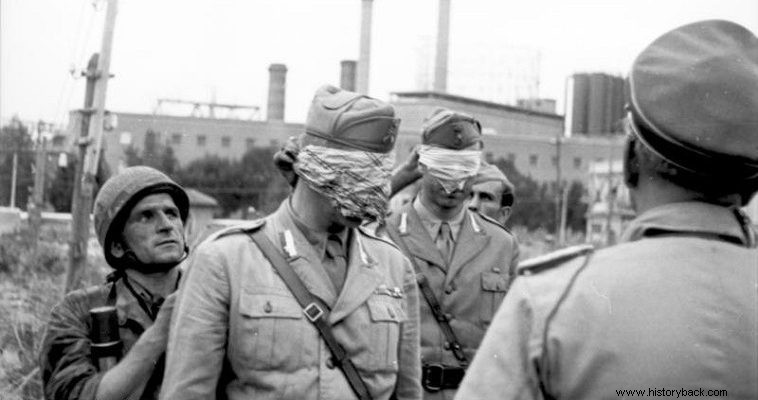
September 22nd, 1943 - and the following days - is a date that is forever destined to unite two peoples, who just three years ago stood in opposite trenches and found themselves fighting together from enemies, one the old and the other another his new dynast. Milestone of this collaboration of old enemies on the new common battlefield, the specific date, which remained in the common memories of Greeks and Italians as "the Massacre of Kefalonia".
From the day of the Italian capitulation, on September 8, 1943, Benito Mussolini's forces in Greece (as well as on other fronts, moreover) found themselves in front of a critical dilemma. Would they join the fascist dictator, who had taken refuge in northern Italy and was setting up a puppet in the hands of Hitler's "Government of Salo", or would they secede and capitulate to the Allied Powers?
In the occupied Ionian Islands, the Italian forces of the Acqui division exercised military control, together with subordinate German forces, who could, however, count on air, as well as sea, support from German bases on the nearby continental coasts.
Immediately after the capitulation of Badolio and the Germans' ultimatum as to which side they would choose and what their fate would be in the future (continuation of the war, or captivity), the forces of Aqui, under General Gadin and his lieutenant Colonel Lusignani of the 18th infantry regiment in Corfu, attempted to obstruct and pursued a delaying policy awaiting clear orders from the General Staff in Rome.
During the following days and while negotiations with the Germans continued, a number of skirmishes took place between the two former allied armies. During these incidents, the German garrison in Corfu was captured.
In general, in the ranks of the Italian forces in the Ionian, the feeling of resistance against the Germans had begun to gain ground, and many officers aimed even to seduce the manu militari of the hitherto divisive Godin, to side with the allied forces. This was not necessary, however, because from Brindisi—where the Italian Staff had taken refuge following King Vittorio Emmanuel—the order arrived to regard the German troops as hostile and to take the appropriate actions.
Faced with the three perspectives:surrendering arms, joining forces with the Germans, or resisting, Godin preferred the latter. He sent an announcement to the Germans that he was not surrendering his weapons and at the same time sent a request to the Italian Staff for air and sea reinforcement of his forces in the Ionian.
Soon the German forces launched their attack. Despite strong Italian resistance, superior German forces with steadily arriving reinforcements, aided by Stuka bombers and continuous air and sea bombardment, forced Gadin to raise the white flag on September 22.
1,200 Italian soldiers and 65 officers lost their lives in the clashes, while even after the ceasefire another 155 officers and 4,700 soldiers were gradually executed as "rebels", even though they were wearing the uniform of the Italian army.
Immediately after the surrender of the Italians, the German general Lands, asked for instructions from the headquarters of the German forces in Epirus on how he should deal with the Italian prisoners, which replied that Gadin and his soldiers should be treated, provided for by the orders of the Führer.
Between September 23-28, Gandin and 200 other officers were put on trial. Gadin was executed on the 24th of the month. In Corfu, the Italian losses amounted to 640 dead and 1,200 wounded, but after the capitulation, the mass executions began, including the leaders of the Lusignani and Bettini forces there. 129 officers were executed in the so-called Casa Rosa (red house) and on September 25 another seven met the same fate, because two more officers were found to have escaped from the hospital where they were being treated.
And the ordinary Italian soldiers in Corfu were considered prisoners of war—perhaps because the German commanders, due to the presence of more flexible officers on the island, interpreted the "Führer's orders" more favorably and were transferred to detention camps, in contrast to the corresponding forces in Kefalonia, where owing to the presence of Lands and Brigadier von Hirschfeld, the executioner, they applied the most extreme punishments to the prisoners.
Atrocious executions began to take place, many Italians took refuge in the homes of local Kefallonians, who, forgetting their old enmity, hid them and treated them. until they find a way to escape or go into resistance.
After the crime, the Germans tried to cover up their heinous act by putting the surviving servicemen on ships bound for Germany. One of the first boats, the "Ardena" exploded off the harbor and out of the 840 Italians in its holds only 120 were saved. The few who survived followed the fate of their other 600,000 comrades who refused to fight under the Salo flag on the side of the Germans and ended up in the Nazi lagers.
However, to this day, the victims of the "Massacre of Kefalonia", the soldiers of the Akui division, have not had their sacrifice recognized as "victims of a war crime". Although the leaders of the Massacre were tried by the Nuremberg courts, the victims of the bloody events in Kefalonia and Corfu—as the German historian Gerhard Schreiber notes—to this day "are unknown in Germany itself, if not completely denied." their sacrifice".
Today, at the site of their slaughter, only a humble marble column reminds us that 10,260 Italian soldiers gave their lives on the Ionian Islands.
SOURCE:APE-ME
